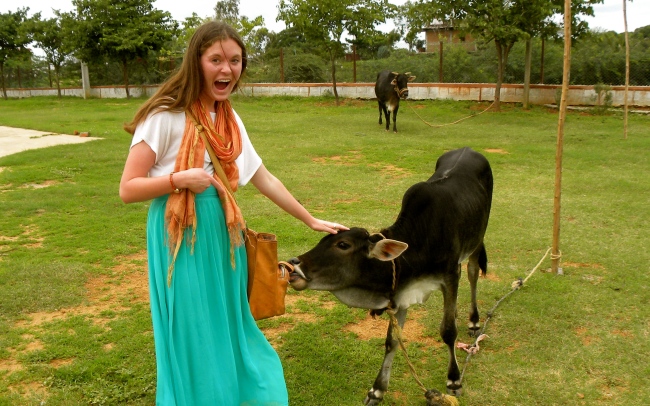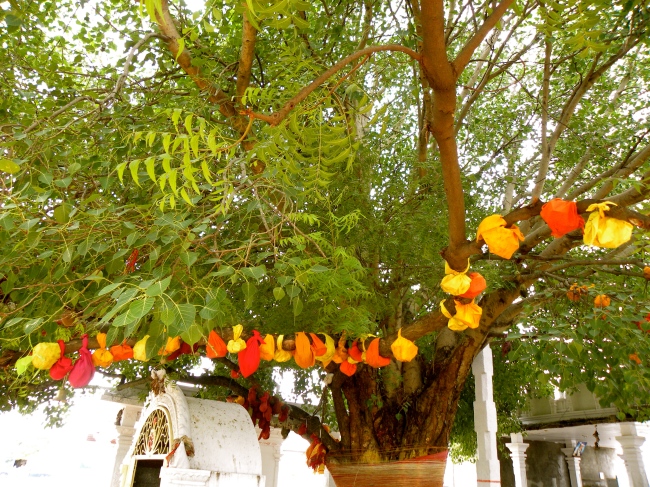This weekend we returned to our project’s initial focus on women’s rights, visiting two incredible programs that work to empower marginalized women. On Saturday, we drove about an hour and a half to the M.V. Foundation, an organization that educates former girl child laborers until they are capable of entering a formal school setting (typically a process that lasts six months to one and a half years). When I say child labor, I don’t necessarily mean that these girls were working in sweatshops–the beauty of MVF is that it has changed the official definition of child laborer to mean any child that is not in school. I’ve mentioned before that the Constitution protects a child’s right to free and compulsory education. MVF believes that it’s just this simple: it does not matter whether a child is “needed” to work at home, a parent should always protect a child’s right to education. Now, the example of Leelavati I gave previously should show that it’s a lot more complicated than this–but I was so grateful to find an organization that is willing to stand up for this right, no matter what. The girls at this school study from about 5:30 am (yoga) until dinner at 7:30 pm, with a couple of hours free for lunch and recreation time. One teacher is assigned to a group of around 15 to 20 students for their entire stay, and this teacher lives with the students full time, acts as their counselor, and receives their feedback. (I can’t even imagine the kind of commitment that takes.) Once a child is ready to enter a residential school, volunteers continue to track the child, ensuring that she is excelling until graduation from the 10th class. MVF also works within the communities where they send their students, building PTA organizations that will create a community investment in each local school. Oh, and it’s all free. Yeah. We were amazed too. 
(On our way to MVF, we stopped at a temple for lunch. And the calf outside decided to taste leather for the first time. Awks.)
On Sunday, we again drove about an hour and a half into the countryside to Ankuram Women and Child Development Center, a shelter for girls who have been victims of violence and exploitation. We were instructed to not ask any personal questions about the girls’ lives, and so the visit felt like it could have been a visit to any girls’ hostel–all of the girls (63 total, who looked between about 6 and 17), were clean, well-dressed, happy, healthy, independent. They explained to us how they are elected to 5 committees (health, recreation, invitation, education, and food), which oversee the day-to-day activities at the home, from caring for a sick child to planning the day’s menu to sitting on the Child Protection Committee. Some girls are in just starting school; one is studying for her B.A. in fine arts. The girls are organized into “families” of 3 sisters of varying ages–the “sisters” study together, care for each other, look out for one another. The community here is one of complete integration and total support. What’s surprising is that there’s no one who lives full time with the girls. How is it that girls who have experienced such unthinkable traumas can be so self-sufficient? Ankuram does incredible work, giving these girls an open space where they are empowered and given the ability to be kids again. As we played “beating ball” (German dodgeball), avoiding the two cows in the courtyard, it all felt so normal, so peaceful. Watching the students sing, or try to teach us to Bollywood dance (tip for DukeEngage Academy? Teach us how to dance so we don’t look like fools in every school we visit), made me feel so comforted to know that these girls have not been defined merely by their past experiences. And now, they are learning how to fight for their own rights.
The organic garden the students planted.
On Sunday night, we went shopping at the Begum Bazaar, which is especially crowded in the evenings. We had been shopping for a couple of hours, haggling over bangles and books and saris, when our driver called and told us he’d just spoken to the police: they believed their was a bomb planted in the area. I had wondered why speakers everywhere were constantly telling us to be on the lookout for unwatched luggage or empty vehicles, but I assumed that was the norm, like at the airport or a train station. A bus honked and I nearly jumped out of my skin as we wound our way back through the crowded streets to the car, and I couldn’t help wondering: will that sugar cane juice stand explode when I walk past? What about that sack of garbage in that alleyway? It was then I realized just how dangerous a city like Hyderabad could be: soldiers with rifles were searching everywhere, but how was it possible to find anything in such a packed, yet sprawling area? We had to wait for minutes that seemed like hours at the car, because it had been booted (no parking zone). (Side note: this experience has caused me to be very anti-booting. Just give us a ticket and let us leave.) We’re safe, and no bomb ever exploded. But still. The world is a scary, scary place.


